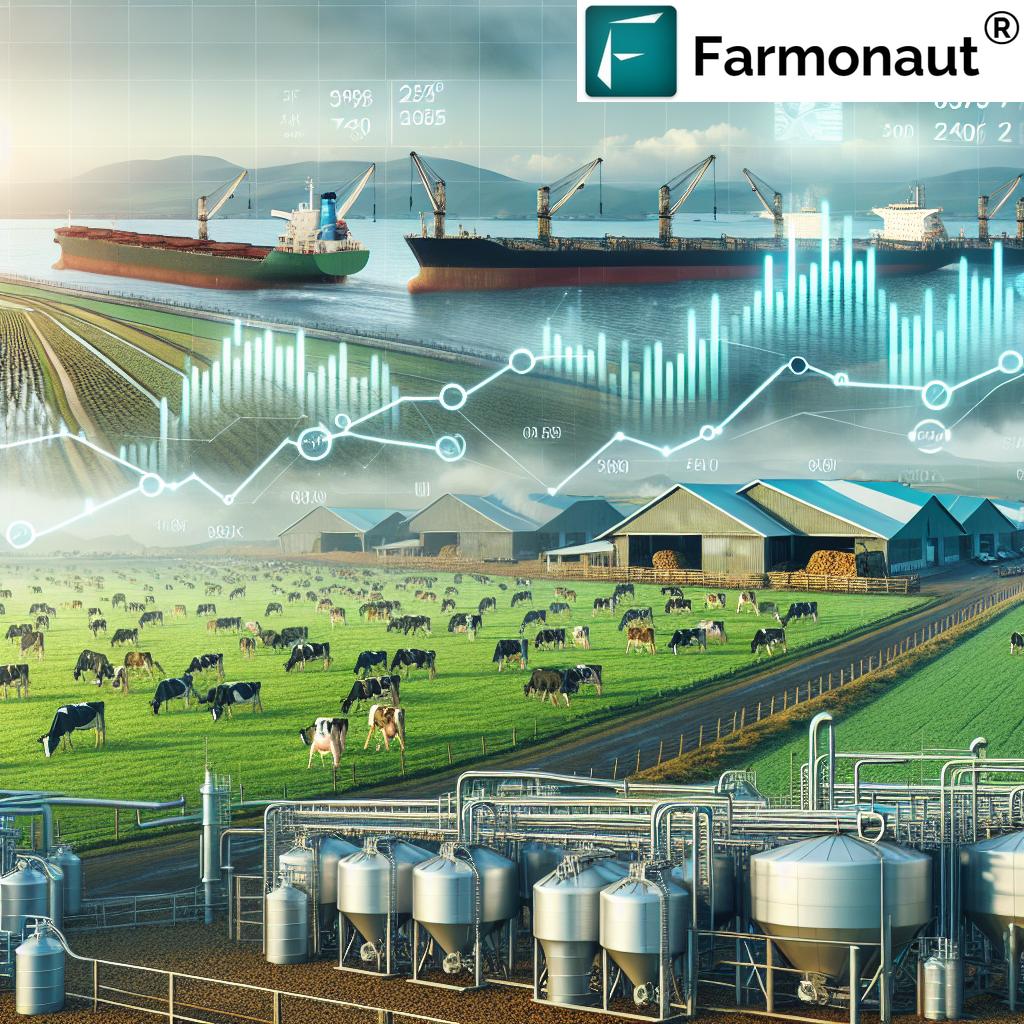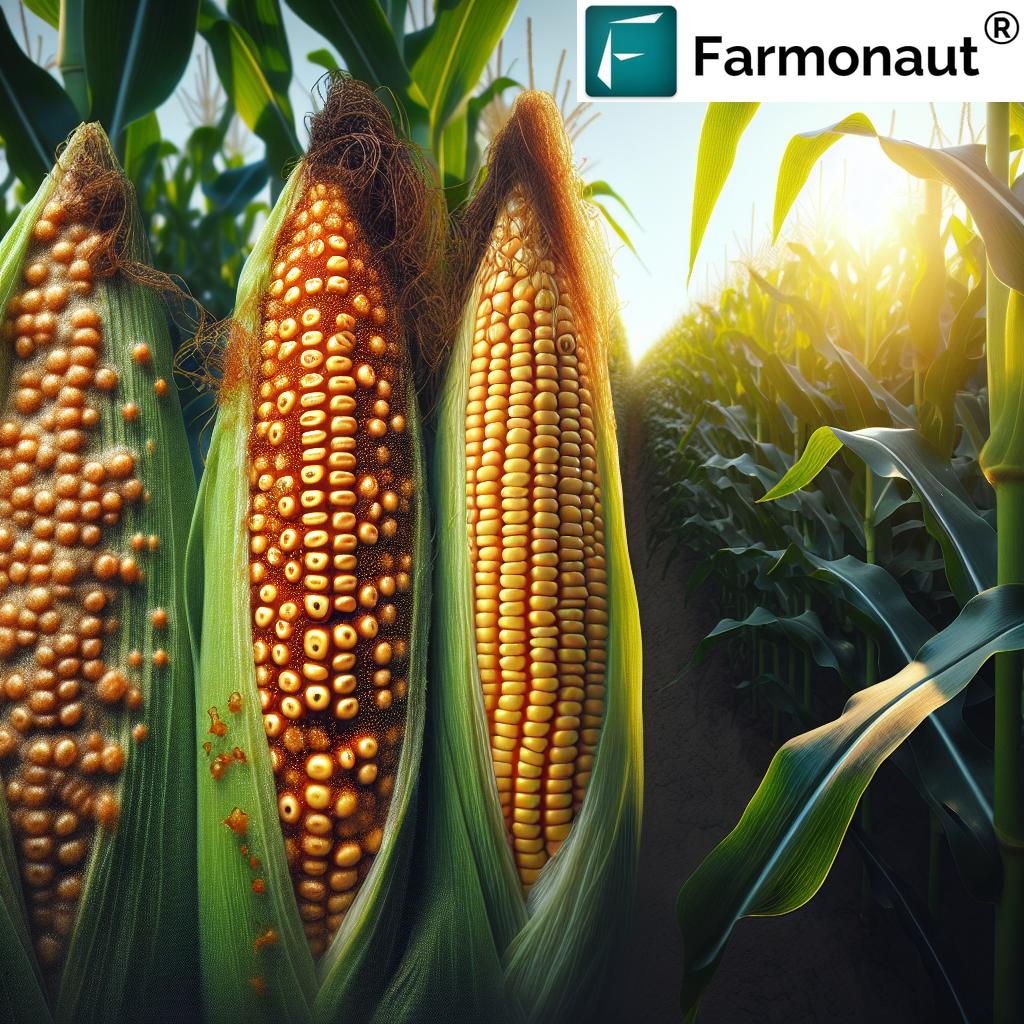Global Dairy Market Outlook: Milk Prices Set to Ease Amid Surging Production and Demand
“Global milk production is forecasted to create a surplus, with prices expected to ease in coming months.”
In the ever-evolving landscape of global agriculture, the dairy industry stands as a crucial pillar, influencing economies, nutrition, and livelihoods worldwide. As we delve into the latest global dairy market outlook, we’re witnessing a fascinating interplay of supply, demand, and pricing dynamics that are reshaping the industry’s future. Our comprehensive analysis reveals that global milk prices are poised for a downturn in the coming months, a trend that carries significant implications for farmers, consumers, and stakeholders across the dairy value chain.
At Farmonaut, we understand the importance of staying ahead of market trends in agriculture. While our primary focus is on cutting-edge satellite-based farm management solutions, we recognize the interconnectedness of various agricultural sectors. That’s why we’re committed to providing valuable insights that can help farmers and agribusinesses make informed decisions, regardless of their specific niche within the industry.
The Current State of the Global Dairy Market
The global dairy industry is currently experiencing a period of significant change, characterized by increased production, shifting demand patterns, and evolving economic conditions. Let’s break down the key factors influencing the market:
- Surging Production: We’re observing robust milk production in both hemispheres, contributing to a growing global supply.
- Changing Demand Dynamics: While demand remains strong in some regions, others are experiencing shifts due to economic factors and changing consumer preferences.
- Price Fluctuations: The interplay between supply and demand is leading to notable milk price fluctuations across different markets.
- Economic Recovery: The ongoing global economic recovery is influencing consumption patterns and export opportunities.
These factors collectively paint a complex picture of the dairy industry’s near future, with implications that extend far beyond the farm gate.

Milk Production Forecast: A Global Perspective
The milk production forecast for the coming months indicates a significant increase in global supply. This surge in production is attributed to several factors:
- Favorable Weather Conditions: Many key dairy-producing regions have experienced optimal weather, boosting yields.
- Improved Farm Management: Advancements in farm technology and management practices have led to increased efficiency and productivity.
- Expansion of Dairy Herds: Some regions have seen an expansion in dairy cattle numbers, contributing to higher overall production.
These factors have culminated in a robust increase in milk supply across both the Northern and Southern hemispheres. The implications of this production surge are far-reaching, affecting everything from farm-level economics to global trade dynamics.
At Farmonaut, while we specialize in satellite-based crop monitoring, we recognize the importance of understanding broader agricultural trends. Our API and API Developer Docs offer valuable tools for agricultural data analysis that can be applied across various sectors, including dairy farming.
Dairy Supply and Demand: A Delicate Balance
The dynamics of dairy supply and demand are at the heart of the current market outlook. While production is on the rise, demand patterns are evolving in complex ways:
- Regional Variations: Demand growth remains strong in some emerging markets, particularly in Asia, while more mature markets are seeing slower growth or even stagnation.
- Economic Factors: The ongoing global economic recovery is influencing consumer purchasing power and preferences, affecting dairy demand in various ways across different regions.
- Changing Consumer Preferences: There’s a growing trend towards plant-based alternatives in some markets, which is impacting traditional dairy demand.
- Export Opportunities: The surplus in production is creating new export opportunities for major dairy-producing countries.
This intricate balance between supply and demand is a critical factor in shaping the global dairy market landscape and influencing price trends.
“Despite projected surplus, structural factors in the dairy industry may limit price reductions below a certain threshold.”
Milk Price Fluctuations: What to Expect
Given the current market conditions, we anticipate significant milk price fluctuations in the coming months. Here’s what dairy farmers and industry stakeholders should be prepared for:
- Overall Price Easing: The increased global supply is expected to exert downward pressure on milk prices.
- Regional Differences: Price trends may vary significantly between regions due to local supply-demand dynamics and trade policies.
- Volatility: We expect to see increased price volatility as the market adjusts to changing supply and demand patterns.
- Structural Price Floors: Despite the downward trend, certain structural factors in the industry may prevent prices from falling below specific thresholds.
For dairy farmers, these price fluctuations underscore the importance of efficient farm management and cost control. While Farmonaut’s primary focus is on crop monitoring, our technology can be adapted to support various aspects of farm management, including resource optimization in dairy operations.

The Role of Agricultural Economics
Agricultural economics plays a crucial role in shaping the dairy industry’s landscape. The interplay between production costs, market demand, and pricing mechanisms creates a complex economic environment that farmers must navigate. Key economic factors influencing the dairy sector include:
- Input Costs: Feed prices, labor costs, and energy expenses significantly impact farm profitability.
- Market Access: Trade policies and international market access affect export opportunities and domestic price stability.
- Government Policies: Subsidies, quotas, and other policy interventions can significantly influence production decisions and market dynamics.
- Consumer Income: Changes in consumer purchasing power directly impact demand for dairy products.
Understanding these economic factors is crucial for dairy farm management and strategic planning. While Farmonaut’s expertise lies in satellite-based farm monitoring, our data-driven approach can provide valuable insights for economic analysis in various agricultural sectors.
Challenges and Opportunities in Dairy Farm Management
Dairy farm management is becoming increasingly complex in the face of current market trends. Farmers are confronted with both challenges and opportunities:
Challenges:
- Cost Management: With potential price decreases, efficient cost control becomes even more critical.
- Market Volatility: Adapting to rapid price fluctuations requires agile management strategies.
- Sustainability Pressures: Growing environmental concerns necessitate more sustainable farming practices.
- Technological Adoption: Keeping pace with technological advancements can be challenging but necessary for competitiveness.
Opportunities:
- Efficiency Gains: Adopting new technologies can lead to significant improvements in productivity and resource use.
- Diversification: Exploring value-added products or alternative revenue streams can help offset market volatility.
- Export Markets: The global surplus may open new export opportunities for efficient producers.
- Data-Driven Decision Making: Leveraging data analytics can lead to more informed and profitable farm management decisions.
While Farmonaut’s primary focus is on crop monitoring, many of our technologies and approaches can be adapted to support dairy farm management. Our satellite-based monitoring and AI-driven analytics can provide valuable insights for resource management and operational efficiency in dairy farming.
Global Perspectives: Key Markets and Their Influence
The global dairy market is influenced by several key players and regions. Understanding their roles is crucial for grasping the overall market dynamics:
- European Union: As a major producer and exporter, EU policies and production levels significantly impact global markets.
- New Zealand: The world’s largest dairy exporter, New Zealand’s production trends have a substantial effect on global supply and prices.
- United States: A significant producer and consumer, US market trends can influence global dairy dynamics.
- China: As the world’s largest dairy importer, China’s demand fluctuations can dramatically affect global markets.
- India: The world’s largest milk producer, primarily for domestic consumption, India’s production trends are increasingly relevant to global markets.
These key players shape the global dairy landscape through their production volumes, consumption patterns, and trade policies. For dairy farmers worldwide, understanding these global dynamics is crucial for strategic planning and risk management.
The Impact of Feed Costs on Dairy Production
Feed costs represent a significant portion of dairy production expenses, making them a critical factor in the industry’s economics. Current trends in feed markets are having a notable impact on dairy production:
- Lower Feed Costs: Recent trends indicate a decrease in global feed prices, potentially easing pressure on dairy farmers’ operating costs.
- Regional Variations: Feed availability and prices can vary significantly between regions, affecting local production costs.
- Long-term Sustainability: The volatility of feed markets underscores the importance of sustainable feeding practices and potentially exploring alternative feed sources.
While Farmonaut’s expertise lies in crop monitoring, our satellite-based technology can be valuable for assessing forage quality and quantity, contributing to more efficient feed management in dairy operations.
Technological Advancements in the Dairy Industry
Technology is playing an increasingly important role in shaping the future of dairy farming. Key technological trends include:
- Precision Dairy Farming: Advanced sensors and data analytics are enabling more precise management of individual animals and resources.
- Automated Milking Systems: Robotics are revolutionizing the milking process, improving efficiency and animal welfare.
- Genomics: Advances in animal genetics are leading to improvements in productivity, health, and milk quality.
- Data-Driven Decision Making: Big data and AI are enabling more informed decision-making at both the farm and industry levels.
While Farmonaut’s primary focus is on crop monitoring, our commitment to technological innovation in agriculture aligns with these broader trends in the dairy industry. Our expertise in satellite technology and data analytics can potentially be adapted to support various aspects of modern dairy farming.
Environmental Considerations in Dairy Production
Environmental sustainability is becoming increasingly important in the dairy industry. Key environmental considerations include:
- Greenhouse Gas Emissions: The dairy sector is under pressure to reduce its carbon footprint.
- Water Usage: Efficient water management is crucial, particularly in water-stressed regions.
- Waste Management: Proper handling of manure and other waste products is essential for environmental protection.
- Biodiversity: Sustainable dairy farming practices can play a role in preserving local ecosystems.
While Farmonaut’s primary focus is on crop monitoring, our technology can potentially be adapted to support environmental monitoring in dairy operations, contributing to more sustainable farming practices.
Global Milk Production and Price Forecast
| Year | Global Milk Production (Million Tonnes) | Average Milk Price (USD/100kg) | Feed Cost Index | Demand Growth Rate (%) |
|---|---|---|---|---|
| 2024 | 880 | 40.5 | 105 | 1.8 |
| 2025 | 895 | 39.0 | 102 | 1.7 |
| 2026 | 910 | 38.5 | 100 | 1.6 |
| 2027 | 925 | 38.0 | 99 | 1.5 |
| 2028 | 940 | 37.5 | 98 | 1.4 |
Strategies for Dairy Farmers in a Changing Market
Given the current market outlook, dairy farmers should consider the following strategies:
- Cost Optimization: Focus on improving operational efficiency to maintain profitability in the face of potential price decreases.
- Diversification: Explore opportunities in value-added products or alternative revenue streams to mitigate market risks.
- Technology Adoption: Embrace new technologies that can improve productivity and resource management.
- Sustainability Initiatives: Implement environmentally friendly practices that can also lead to cost savings and market differentiation.
- Market Intelligence: Stay informed about global market trends and adjust strategies accordingly.
While Farmonaut’s primary expertise is in crop monitoring, many of these strategies align with our broader mission of promoting data-driven, efficient agriculture. Our technology can potentially be adapted to support various aspects of dairy farm management, from resource optimization to environmental monitoring.
The Future of the Global Dairy Industry
As we look to the future, several trends are likely to shape the global dairy industry:
- Increased Consolidation: We may see further consolidation in the industry as economies of scale become increasingly important.
- Technological Integration: Advanced technologies like AI, IoT, and blockchain are likely to become more prevalent in dairy farming and supply chain management.
- Sustainability Focus: Environmental considerations will play an increasingly important role in shaping industry practices and consumer preferences.
- Changing Consumer Preferences: The industry will need to adapt to evolving consumer tastes, including the growing demand for plant-based alternatives in some markets.
- Global Trade Dynamics: Ongoing changes in international trade policies and agreements will continue to impact global dairy markets.
While Farmonaut’s primary focus is on crop monitoring, our commitment to technological innovation in agriculture positions us to potentially contribute to these broader trends in the dairy industry. Our expertise in satellite technology and data analytics could be adapted to support various aspects of the evolving dairy sector.
Conclusion
The global dairy market is entering a period of significant change, characterized by easing milk prices amid surging production and evolving demand dynamics. While this presents challenges for dairy farmers and industry stakeholders, it also offers opportunities for those who can adapt to the changing landscape.
Key takeaways from our analysis include:
- Global milk production is on the rise, creating a potential surplus in the market.
- Milk prices are expected to ease in the coming months, though structural factors may limit the extent of price reductions.
- Efficient farm management, cost control, and strategic planning will be crucial for dairy farmers navigating these market conditions.
- Technological advancements and sustainability initiatives will play an increasingly important role in shaping the industry’s future.
While Farmonaut’s primary expertise lies in satellite-based crop monitoring, many of the trends and challenges facing the dairy industry align with our broader mission of promoting data-driven, efficient, and sustainable agriculture. As the agricultural sector continues to evolve, we remain committed to developing innovative solutions that can benefit farmers across various domains, including dairy production.
By staying informed about market trends, embracing technological innovations, and focusing on efficiency and sustainability, dairy farmers and industry stakeholders can position themselves to thrive in this dynamic global market.
FAQ Section
- Q: What are the main factors driving the expected easing of global milk prices?
A: The main factors include increased milk production in both hemispheres, changes in global demand patterns, and lower feed costs. - Q: How might the easing of milk prices affect dairy farmers?
A: Dairy farmers may face reduced profit margins, necessitating a focus on cost optimization and efficiency improvements to maintain profitability. - Q: What role does China play in the global dairy market?
A: As the world’s largest dairy importer, China’s demand fluctuations can significantly impact global dairy markets and prices. - Q: How are technological advancements impacting the dairy industry?
A: Technologies like precision farming, automated milking systems, and data analytics are improving efficiency, animal welfare, and decision-making in dairy operations. - Q: What strategies can dairy farmers adopt to navigate the changing market conditions?
A: Strategies include cost optimization, diversification into value-added products, technology adoption, sustainability initiatives, and staying informed about market trends.



















